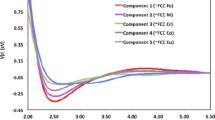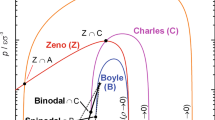Abstract
For defective water associates with an extra hydrogen atom (n-defective associates), size and structure effects on ionization potentials compared to defectless (normal) associates of similar structures have been investigated by quantum chemical and molecular mechanics methods. The ionization potentials of small n defective water associates increase (from fractions of eV to 7 eV–8 eV) with the number of water molecules in the associate. These are most probably the source of a hydrated electron that are responsible for the ensuing equilibrium between all defects in liquid water: neutral n and p defects and ion defects (H +aq , OH −aq , e −aq ). Delocalization of an odd electron in defective associates stabilizes the latter and promotes their recombinations, forming hydrated water molecules, hydrogen peroxide, and gaseous hydrogen. Structural instability of “fullerene” (H2O)20 relative to normal associates has been found. This compound is stabilized by the endo inclusion of a hydrogen atom, and exo fixation of the hydrogen atom gives rise to an extra source of hydrated electrons.
Similar content being viewed by others
REFERENCES
G. A. Domrachev and D. A. Selivanovsky, “The role of sound and liquid water as dynamically unstable polymer system in abiogenous production of oxygen and the origin of life on the earth,” Preprint No. 1’90, Institute of Organometallic Chemistry, USSR Academy of Sciences, Gorky (1990).
G. A. Domrachev, Yu. L. Rodygin, and D. A. Selivanovskii, Vysokochist. Veshchest., No. 5, 187–189 (1991).
G. A. Domrachev, Yu. L. Rodygin, and D. A. Selivanovskii, Zh. Fiz. Khim., 66, No.3, 851–855 (1992).
G. A. Domrachev, A. V. Mayorova, Yu. L. Rodygin, and D. A. Selivanovskii, Akust. Zh., 39, No.2, 258–265 (1993).
G. A. Domrachev, Yu. L. Rodygin, D. A. Selivanovskii, and P. A. Stunzhas, Dokl. Ross. Akad. Nauk, 329, No.2, 186–188 (1993).
G. A. Domrachev, V. V. Mityugov, Yu. L. Rodygin, and D. A. Selivanovskii, Abstr. All-Union School Sem. Bio-Thermo-Chemiluminescence, P. 2, USSR Ministry of Electrotechnical Industry and Instrument Making, Suzdal (1990), p. 53.
G. A. Domrachev and D. A. Selivanovskii, ibid., p. 55.
G. A. Domrachev, Yu. L. Rodygin, D. A. Selivanovskii, and P. A. Stunzhas, The 7th Int. Ann. Workshop “Laboratory Modeling of Dynamic Processes in the Ocean,” Institute of Problems in Mechanics, Russian Academy of Sciences (1993), p. 29.
V. L. Vaks, G. A. Domrachev, Yu. L. Rodygin, et al., Izv. Vyssh. Uchebn. Zaved., Radiofiz., No. 1, 149–154 (1994).
G. A. Domrachev, Yu. L. Rodygin, and D. A. Selivanovskii, Vestn. Nizhegorodsk. Gos. Un-ta N. I. Lobachevskogo, Organic and Organoelement Peroxides, Nizhnii Novgorod State Univ., Nizhnii Novgorod (1996), pp. 107–114.
G. A. Domrachev, D. A. Selivanovskii, Yu. L. Rodygin, and I. N. Didenkulov, Zh. Fiz. Khim., 72, No.2, 340–345 (1998).
G. A. Domrachev, D. A. Selivanovskii, Yu. L. Rodygin, et al., ibid., 347–352.
G. A. Domrachev, D. A. Selivanovskii, I. N. Didenkulov, et al., ibid., 315–320.
Y. V. Novakovskaya and N. F. Stepanov, ibid., 74, No.2, 216–227 (2000).
Y. V. Novakovskaya and N. F. Stepanov, J. Phys. Chem. A, 103, No.17, 3285–3288 (1999).
Y. V. Novakovskaya and N. F. Stepanov, ibid., No. 50, 10975–10980.
Y. V. Novakovskaya and N. F. Stepanov, Chem. Phys. Lett., 344, Nos.5/6, 619–624 (2001).
Y. V. Novakovskaya and N. F. Stepanov, Zh. Fiz. Khim., 74, No.1, 63–70 (2000).
Y. V. Novakovskaya and N. F. Stepanov, Int. J. Quant. Chem., 88, No.4, 496–506 (2002).
J. J. P. Stewart, J. Comp.-Aided Mol. Des., 4, No.1, 1–105 (1990).
D. J. Anick, J. Mol. Struct. (Theochem), No. 587, 87–96 (2002).
D. J. Anick, ibid., 97–100.
N. Maeno, The Science of Ice [Russian translation], Mir, Moscow (1988).
L. V. Gurvich, G. V. Karachevtsev, V. N. Kondratiev, et al., Chemical Bond Cleavage Energies. Ionization Potentials and Electron Affinities [in Russian], Nauka, Moscow (1974).
V. S. Fomenko, Emission Properties of Materials, Handbook [in Russian], Naukova Dumka, Kiev (1981).
G. N. Zatsepina, Physical Properties and Structure of Water [in Russian], Moscow State Univ., Moscow (1987).
V. Ya. Antonchenko, A. S. Davydov, and V. V. Il’in, Fundamentals of Water Physics [in Russian], Naukova Dumka, Kiev (1991).
G. A. Domrachev and A. I. Lazarev, Fiz. Tverd. Tela, 41, No.5, 799–804 (1999).
H. A. Schwarz, J. Phys. Chem., 96, No.22, 8337–8341 (1992).
R. O. Watts and I. J. McGee, Liquid State Chemical Physics, Wiley, New York (1976).
Author information
Authors and Affiliations
Additional information
Original Russian Text Copyright © 2004 by G. A. Domrachev, D. A. Selivanovskii, E. G. Domracheva, L. G. Domracheva, A. I. Lazarev, P. A. Stunzhas, S. F. Shishkanov, and V. L. Vaks
Translated from Zhurnal Strukturnoi Khimii, Vol. 45, No. 4, pp. 670–677, July–August, 2004.
Rights and permissions
About this article
Cite this article
Domrachev, G.A., Selivanovskii, D.A., Domracheva, E.G. et al. The role of neutral defects in the structural chemistry of liquid water. J Struct Chem 45, 636–642 (2004). https://doi.org/10.1007/s10947-005-0038-1
Received:
Issue Date:
DOI: https://doi.org/10.1007/s10947-005-0038-1




